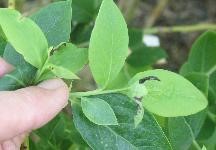Suwannee County is home to many blueberry farms and U-pick operations where customers can go and pick themselves buckets of yummy berries. Blueberry growers have been preparing for harvest season for many months and are now so excited to be able to share their products. To get the plants where they are today, it took a lot of time and energy from the growers and it is not always easy. From varying spring temperatures to new pests and diseases they are faced with, growers made it through. One pest that can greatly affect blueberry yield, is the blueberry gall midge. Read on to find out more about the blueberry gall midge and its detrimental effects on the southern highbush blueberry.
What is a Blueberry Gall Midge?

The blueberry gall midge is a small flying insect that is found throughout the United States and here in Florida. It is found on blueberries and cranberries where its larvae feed on buds and leaves. Adult blueberry gall midges in north-central Florida are active starting in November, but their activity peaks in February to March. Adult males will typically emerge about two weeks before adult females and this emergence is usually caused by the change in temperatures from cool to warm.
Identification:

The blueberry gall midge starts as a tiny white circular egg about 0.25 mm in length and will hatch within 2 to 3 days into young larvae. The young larvae are translucent or white in color for the first few days. After a week they will mature, their color will change to orange and they will feed on the interior tissue of flower and leaf buds. After the larval stage, they will drop from the bushes to the ground where they will pupate in the soil. Once they emerge, they will be in their adult life stage.
The adult blueberry gall midge is about 2 – 3 mm in length, but females are slightly larger than males. Their color is usually a light yellow or cream. Once the fly reaches the adult life stage, they live for only 2 to 3 days. Adult females will lay eggs in the folds of flowers and leaf buds. They can lay about 15 eggs per bud.
Crop Damage:

Gall midge larvae will feed on flower bud tissue causing bud abortion, poor fruit set, brown lesions, necrosis, and overall yield loss. They will also feed on new leaf growth causing deformed/misshapen leaves and blackened bud tips on emerging foliage. During harvest, the midge populations will usually decrease because there are fewer developing flowers and leaf buds available. However, following harvest season, it is important to continue to monitor the field because once you begin to prune, new vegetation and flower buds will grow, creating new places for the midge to lay eggs.
Cultural Controls:
Monitor for adult gall midges using:
- White bucket traps with a sticky plexiglass top placed under bushes directly on the ground (3-5 traps per acre)
- Clear sticky traps hung on the sides of blueberry bushes close to the ground (1-3 traps per acre)
Chemical Controls:
- Chemical controls should be used when two or more adults are found in traps.
- Spraying for adult midges before they eggs is important.
- If pollinators are present: Delegate target adults in the field, but should be re-applied weekly due to its short residual activity.
- If pollinators are not present: Assail or Admire Pro target larvae that are hidden in buds and Exirel or Movento target both larvae and adults.
Always remember to read the label and follow directions before applying any chemicals in your field.
UF/IFAS Extension in Suwannee County is an Equal Opportunity Institution.
 0
0
